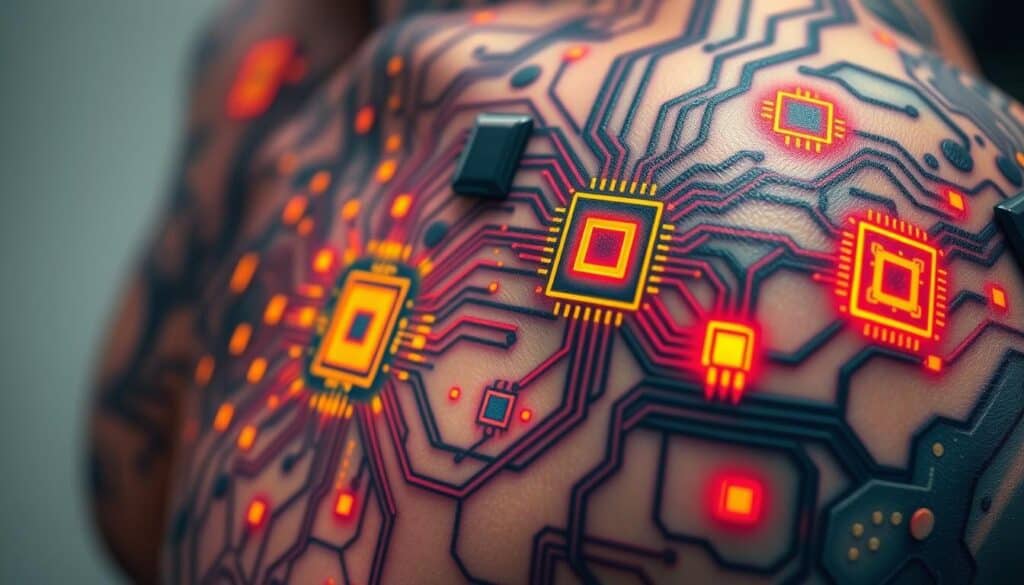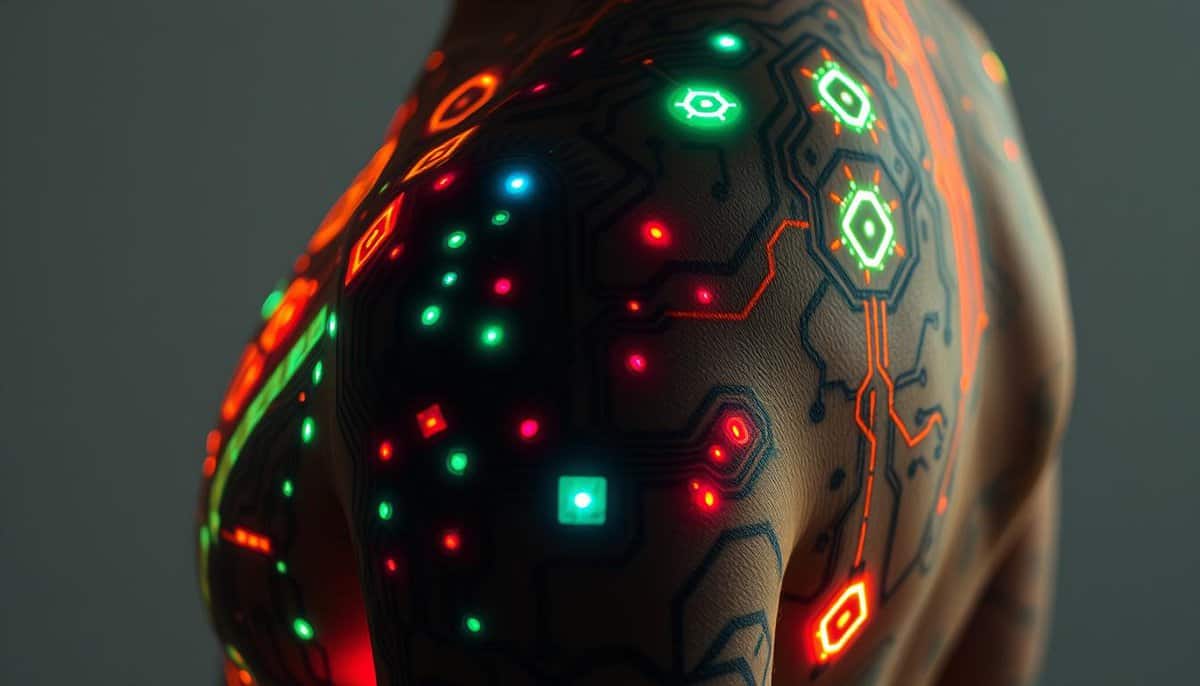Did you know nearly 40% of millennials sport a tattoo? The Pew Research Center revealed this. Tattoos have been meaningful for ages. Now, tech tattoos are adding a new twist. They mix art with technology. Smart tattoos connect with devices, while bioelectronics ink is game-changing.
Devices are getting tinier. So, adding sensors and chips to tattoos is a big move. These tattoos aren’t just for looks. They monitor health, gather data, and link with tech. Imagine a tattoo that watches your health or connects with your phone.
Nanotechnology and 3D printing are changing tattoos. Nanotech makes ink safer and longer-lasting. 3D printing creates precise, custom tattoos. This tech brings more detailed and personal tattoos to life.
The Evolution of Body Art and Technology
Body art has come a long way. It went from ancient cultural markers to modern expressions of self and techno-innovations. This journey shows the growth of art and the deep mix of technology in body art.
A Brief History of Tattoos
Tattoos have been around since ancient times. They were used for spirituality, culture, and personal symbols. Starting in many ancient societies, tattoos showed things like rites of passage, tribe membership, and health uses. As time passed, tattoo art changed, showing shifts in society and tech improvements.
The Rise of Biomechanical Tattoos
Biomechanical tattoos blend organic and mechanical looks. They create the illusion of machine parts mixed with human skin. This style marks a big step in tattoo art, linking traditional art to tech themes. It not only changes how we see tattoos but also opens doors for smart ink and digital skin tech.
Smart ink isn’t just for looks. Scientists at Harvard and MIT made biosensitive inks. These inks change color with body fluid changes, showing blood chemistry shifts. It shows how smart ink can change both the art and use of tattoos. It makes biomechanical tattoos able to monitor health in real time.
New ideas like this are changing the tattoo scene. There’s a push with scientists and artists working together. The e-tattoo from the University of Texas at Austin combines tech with traditional tattoos. It’s light, powered by a small battery, and lasts over 40 hours. It fits into daily life easily while sending health data wirelessly.
Wearable Technological Tattoos: Merging Art and Functionality
Wearable technological tattoos are the height of merging art with tech. These tattoos blend style with tech smarts.

Integration with Wearable Devices
Smart tattoos work well with gadgets like smartwatches and fitness trackers. They make using these devices feel more natural. For example, Microsoft Research’s capacitive tattoos let you control gadgets by touch and last on non-skin surfaces for months.
Applications in Healthcare
In healthcare, these tattoos are changing the game. They track vital signs, offering instant data to doctors and patients. Because they’re thin and flexible, they make monitoring easy to handle every day.
Augmented Reality Enhancements
Augmented reality (AR) will take these tattoos to the next level. They could show cool effects that change with your environment or how you move. This mix of AR and tattoos opens new doors for expressing yourself and using technology.
Smart Ink Innovations and Digital Skin Technology
Smart ink and digital skin technology are changing the game. They’re blending beauty with tech in wearable tattoos. For example, digital skin tech makes tattoos that change color with changes in temperature or light.
Big names like Google and Apple are pouring money into this tech. Projects like Dermal Abyss can check your body for sodium and glucose. Another cool project, DuoSkin, lets tattoos act as touchpads for devices. iSkin lets people design interactive tattoo patterns on their skin.
Digital skin tech is loved for its versatility. It’s not just cool tech; it’s also a breakthrough in healthcare. Over 370 million wearable devices are expected to be sold, proving how big this $25 billion market is. Smart tattoo pigments can even help track UV exposure to prevent skin cancer, according to Dr. Carson Bruns.
Creating smart tattoos is a team effort. Scientists and designers work together to make pigments that check health markers and talk to gadgets. Dr. Daniel Kraft points out their huge potential in health, thanks to their personal touch and non-invasive style.
| Smart Tattoo Project | Developing Institutions | Main Functionality |
|---|---|---|
| Dermal Abyss | Harvard and MIT | Detects sodium and glucose levels |
| DuoSkin | Microsoft and MIT | Touchpad for smart devices |
| iSkin | Max Plank Institute for Informatics and Saarland University | Custom patterns and mobile device control |
| Solar Freckle Tattoo | Dr. Carson Bruns | Monitors radiation and UV light exposure |
| Magic Ink | Dr. Carson Bruns and a celebrity tattoo artist | Commercializing smart tattoo pigments |
The Future of Skin-Thin Devices
Wearable technology is rapidly advancing. It’s merging bioelectronics ink with nanotechnology. This makes our skin an interactive surface. Breakthroughs in tattoo ink nanotechnology are making these devices safer and more colorful. They also last longer. Additionally, 3D printing is bringing tattoos to life with amazing precision. Designs that once were only dreams are now possible.
Nanotechnology in Tattoo Ink
Nanotechnology is changing how tattoo inks are made and applied. This science improves the inks’ safety and visual appeal. It makes the inks safer and colors brighter and more durable. Plus, electronic tattoos only 30 micrometers thick are enhancing medical tests, like EEGs. These e-tattoos can monitor brain waves, setting up in 20 minutes. This is a big improvement over the usual one to two hours.
3D Printing in Tattoos
3D printing is taking tattooing to a new level. It allows for detailed designs and precision that was impossible before. This technology also enables tattoos that monitor health. These tattoos collect important data for healthcare. 3D printed e-tattoos are used in fitness, gaming, and the military. They monitor heart rate and blood pressure, providing valuable information.
The future of devices that are as thin as skin is very bright. This is thanks to the merging of tattoo art and bioelectronics. We are entering a new period of innovation in both personal and medical technology. These smart tattoos are more than just body art. They are a pioneering mix of art, science, and technology you can wear.












it would be great to explore the ethical implications and privacy concerns associated with these data-collecting e-tattoos.
the intersection of art and technology in tattoos
Interesting read, but does the evolution of body art really need the intrusion of technology? Isnt the organic nature of tattoos its real charm?
Privacys long gone in this digital age. Tech tattoos just make it fashionable.
Interesting read! But, dont you think the permanency of tech tattoos might be an issue with rapidly evolving technology?
Fascinating read! But arent we risking our privacy with these tech tattoos? Wheres the line between art and invasive tech?
Art evolves with technology. Privacy concerns? Youre already bugged by your smartphone!
Related Posts
45+ Science Tricks for Games and Marketing: Data-Driven and Statistical Tricks
Use or Abuse 25 Cognitive Biases in Product Design and Manufacturing
Revised NIOSH Lifting Equation in Bench Ergonomics
Dark Web vs Darknet vs Deep Web: 101 & More
Latest Publications & Patents on Cellular Automata
Darknet Tools For Engineering And Science